Roe deer indentation

The roe deer occurs today in practically the whole country. But it has not always been so. From the 1700s the roe deer disappeared in large parts of its distribution area due to ruthless hunting. Soon, the roe deer was only left in small populations furthest south. Thanks to some large landowners giving the roe deer a sanctuary, the species could recover and has since then expanded so that Swedish roe deer now colonize Finland via the Torne Valley.
HABITAT AND HABITS
The roe deer is primarily a forest-dwelling species, but thanks to its great adaptability it occurs in almost all environments, also in purely agricultural landscapes. It thrives best in varied land with protective forest and open areas with herbs and grass. Roe deer can thrive well close to settlements and often stay in farmyards’ parks or visit private gardens and summer cottage plots to search for food.
The roe deer tolerates cold well, but has difficulty accessing its natural food on the ground, especially bilberry stems, in deep snow and crust. Many starve to death during long and snowy winters. Mortality mainly affects fawns, young bucks, and old animals. Supplemental feeding during such winters can save the lives of many roe deer. But feeding should begin already during the autumn, so that the animals have time to get used to it and know where the feeding places are. Also feed in several places since young roe deer have less ability to assert themselves in competition with older ones.
Overaged animals, older than eight years, also usually starve to death during harsh winters. Their worn-down teeth are not able to finely break down the coarser winter diet.
Some estimates suggest that up to 30 percent of a roe deer population dies in a hard and snowy winter. However, it often recovers quickly and after a year the population is back to its previous numbers.
The home range varies in size from south to north, from a few tens of hectares in favorable habitats in the south to an area ten times larger in the north. Migrations between winter and summer habitats occur, mainly in Norrland. The roe deer is most active at dusk and dawn, but in areas where they feel safe the animals also move about in daylight. After leaving the day bed in protected vegetation, they go out to forage in forest edges and in open areas.
The roe deer is quite picky when choosing food. The grazing roe deer moves slowly forward and picks a few leaves here and a few there. Herbs of various kinds as well as leaves and fine twigs from deciduous trees are preferred. Grass is eaten to a lesser extent. During nightly visits to gardens, they eat roses, tulip bulbs, and many other plants in flowerbeds and garden plots. In summer, the diet is dominated by herbs; in autumn and winter, a greater portion of the food consists of twigs and brush.
The male animal is called buck or roe buck. The female animal is called smaldjur (narrow animal) until she has reproduced for the first time, thereafter doe or roe. The young is called kid, fawn, or lamb.
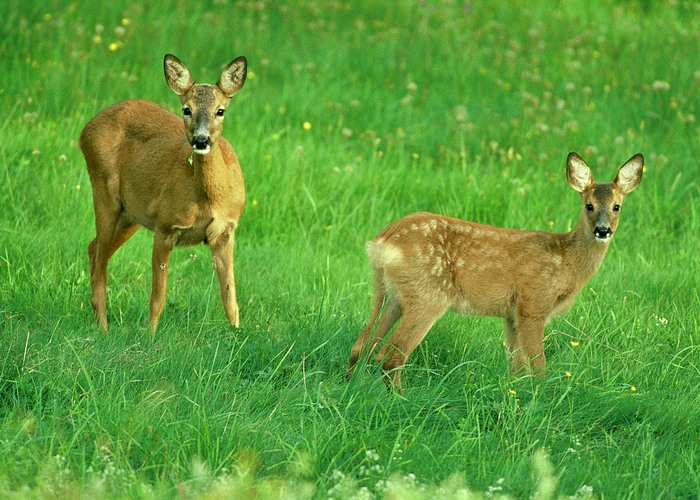
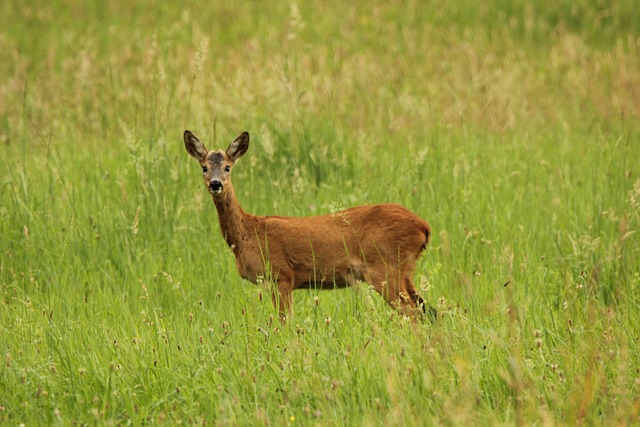
The bucks defend territory already before the antler shedding in spring and defend it against other bucks until the rut, which takes place in late July and early August, is over. The territory is marked by the buck rubbing his antlers against bushes and stems so that twigs break and bark peels off. At the same time, he places scent markings with a gland in the forehead. He also scrapes he scrapes with his hooves in the ground here and there within the territory.
In roe deer territory, a buck is usually three years old when he establishes his own territory. A dominant buck tolerates a few younger bucks in his territory, even if he chases them off when they come too close to him or his does. A roe buck usually becomes mature (capital) at around five years of age. Older bucks’ returning antlers are usually thickened at the horn base and lack or have severely shortened brow tines.
CHARACTERISTICS
Roe deer have completely different coat colors in summer and winter. They shed the thick, gray-brown winter coat in May. During a period, they look worn and shabby with tufts of remaining winter wool in the new reddish-brown summer coat. When buck hunting begins in August, all roe deer wear their reddish-brown summer coat. Toward autumn, the winter coat develops again.
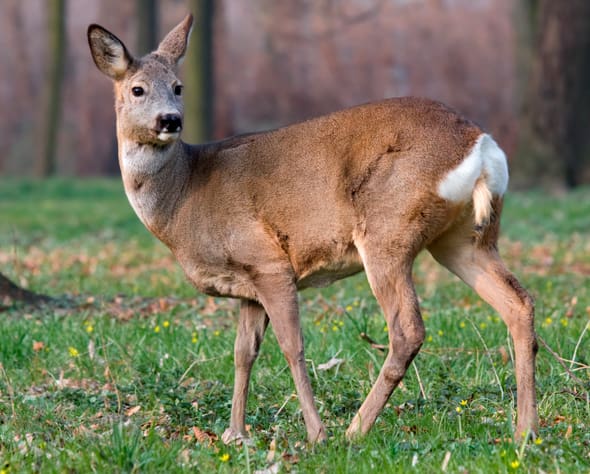
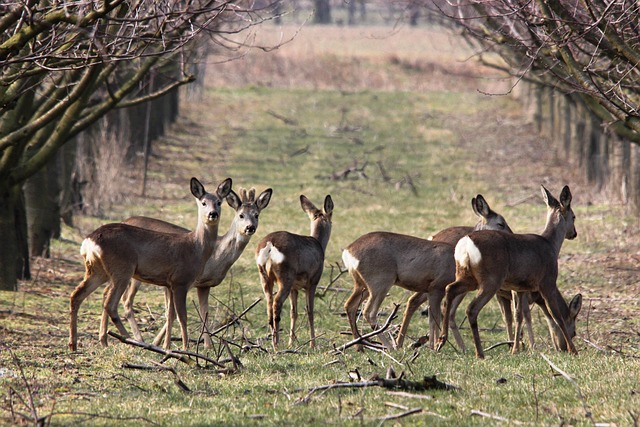
Unlike fallow and red deer, the roe deer has a completely white rump patch with a very short tail stub. The white patch is particularly visible when a startled roe deer jumps away in long, high, and fast leaps. From behind, it’s also clearly visible whether the animal is a buck or a doe. The female has a distinct tuft of hair at the genital opening, under the rump patch.
However, it can be very difficult to distinguish between a doe and a young female (smaldjur). During hunting with a driven dog, the doe often leaves her kids behind and continues alone with the dog following her. When the dog comes with a lone female, it is therefore far from certain that it is a young one. The kids are more or less dependent on the mother and her experience through the whole winter. If she is shot at the beginning or middle of the season, they are likely to die.
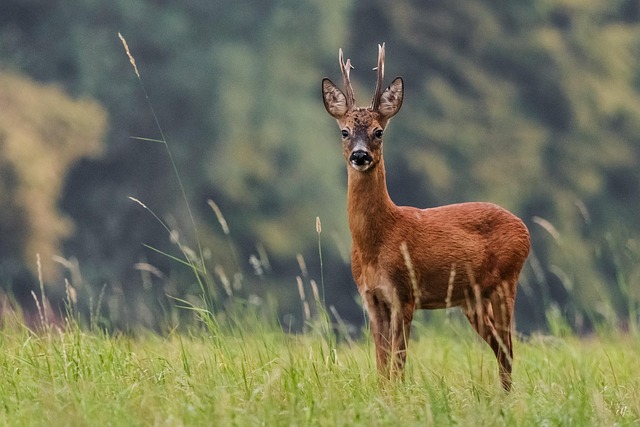
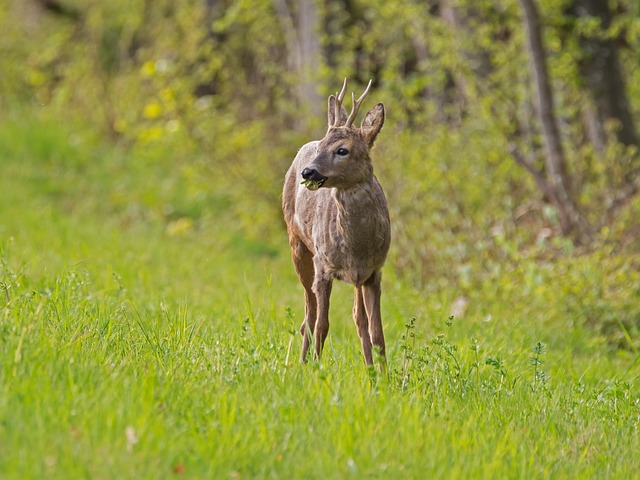
The buck is easily recognized by his antlers, but unlike fallow and red deer, the roe buck sheds his antlers before the hunting season is over. They grow out during the winter, are rubbed clean (velvet removed) in April–May, and are shed in October–December. Older bucks shed their antlers earlier than younger ones. After antler shedding, it is for a period more difficult to distinguish the sexes. But especially with older bucks, the new antlers grow fairly large before the hunting season is over. After the antlers are shed, you can recognize a buck by the “brush” — the tuft of hair around the genitals. With some training, you can also learn to distinguish sex by body size. An adult buck has a thicker neck and looks more powerful with a narrow pointed snout, while especially older does have a more square-shaped body.
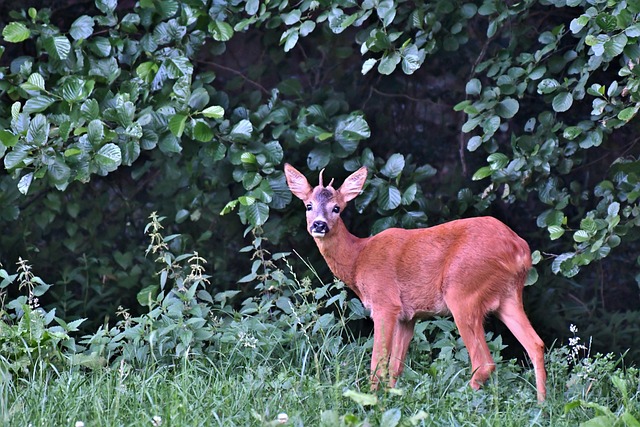
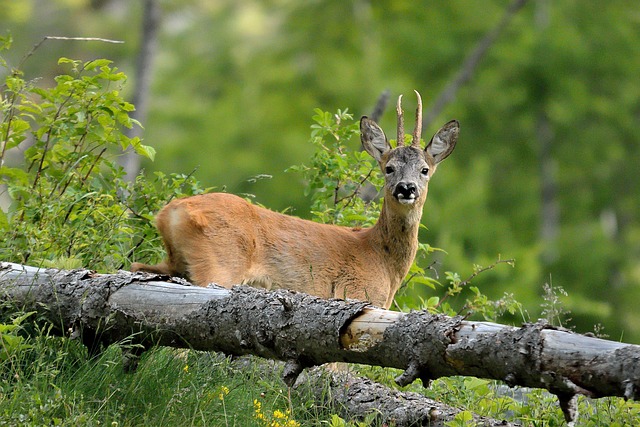
In the first year, the buck usually carries a pair of unbranched antlers and is then called a spike buck. After that, he usually becomes a fork buck (two tines on each antlers) and six-pointers (three tines on each antler). The antlers also increase in thickness until the buck is four to five years old, when his body is at the peak of its development. After that, the antlers regress gradually and become less branched. Such a buck is called a returning buck.
The roe buck’s antler development depends more on genetics and access to nutritious food than on age. Some bucks never become six-pointers, others can become that already at two years of age. Occasionally, one sees bucks with more than six tines.
A roe deer sensing danger shows its concern by barking and warns other roe deer this way. The bark is rough and a bit hoarse and seems to come from a much larger animal. Both sexes bark when threatened. They also sometimes emit a soft whistle during the rut. The contact call between doe and fawn is a weak peeping sound.
Mating and reproduction
During the rut, the buck chases, harasses, a doe in high heat in circles and figure-eights, often so intensely that the vegetation is trampled and so-called witch rings are formed. They mate several times and the buck leaves the doe after a few days to court a new one.
The fawns are born in May–June due to delayed fetal development. There are usually two, but triplets are not uncommon. In the beginning, the fawn lies alone curled up in vegetation, and the doe visits them a couple of times each day to nurse them. Often, the doe places her fawns in hay meadows. Many therefore fall victim to mowing machines. The fox is a significant predator of roe deer fawns. These two causes of death alone account for more than half of all roe deer fawns dying at a young age.
Diseases in roe deer
Roe deer diarrhea is characterized by diarrhea and emaciation. It first affects individual roe deer in an area, then after a while spreads to most of the roe deer. The disease occurs in animals of all ages and both sexes. It is not clear what causes the illness. Nothing suggests that the disease is transmissible to humans or dogs.
Listeriosis occurs in Sweden relatively often in sheep, sometimes in cattle and in roe deer, hares, and red foxes. The bacteria are found in the soil and on feed. Outbreaks in domestic animals have been linked to silage feeding, which is worth considering when feeding wildlife with silage in winter.
The disease causes inflammatory reactions in the form of white lesions in the liver and spleen, as well as inflammation in the brain and meninges. Sick animals often show movement disorders and sometimes walk in circles.
Avian tuberculosis is a bacterial infection that is occasionally seen in roe deer, where it causes pus-filled lesions in the liver, spleen, and lymph nodes. It should not be confused with bovine tuberculosis (bovine TB), which has been detected in penned deer.
Most of the parasites that affect roe deer do not cause any major damage. One serious parasite, however, is lungworm, which mainly occurs in older roe deer. It causes clear, hard changes, primarily in the outer edges of the lungs. Lung capacity is reduced, which impairs the animal’s condition.
Chewing lice, about five millimeters long, are fairly common external parasites on roe deer. They can be seen living in the fur and on the skin. Infestations are seen mainly during winter and spring. Affected animals often show signs of itching and some irritation, but are rarely in poor general condition, except that some may need to be euthanized. Many hunters over the past hundred years have suspected mange, but mange has never been confirmed in roe deer.
External trauma, such as traffic accidents, accidental injuries, or fence injuries, are among the most common natural causes of death in roe deer.
Overgrown hooves, either on one or all four legs, are seen now and then. The cause of these so-called “fast-growing hooves” is unknown, and the condition is also seen in other deer species.
Tracks and hunting
The roe deer leaves many different signs in nature. The small, pointed hoof prints are typical in both size and shape. Trampled paths show where the roe deer move between day beds and feeding areas. The buck’s territorial markings with scraped-up pits and antler rubbing damage on trees and bushes are hard to miss. Droppings and bitten twigs with ragged cut surfaces are other common signs.
In forested areas, roe deer are mainly hunted with driving dogs; otherwise, stand hunting and stalking are the most common hunting methods. Calling hunts also occur. Where populations are dense and the landscape is varied, flushing dogs and short-range trackers are often used.
Regardless of hunting method, the law requires that a trained dog must be available to track down potentially wounded roe deer. Shotguns and rifles of at least class 2 may be used for roe deer hunting.
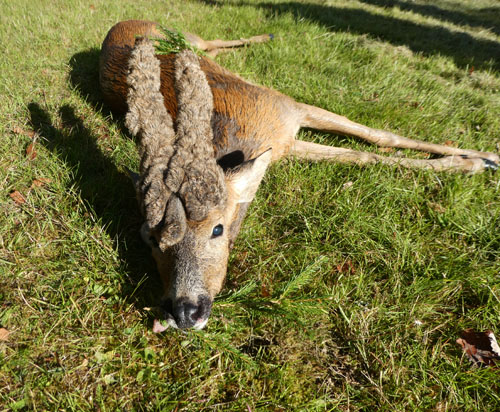
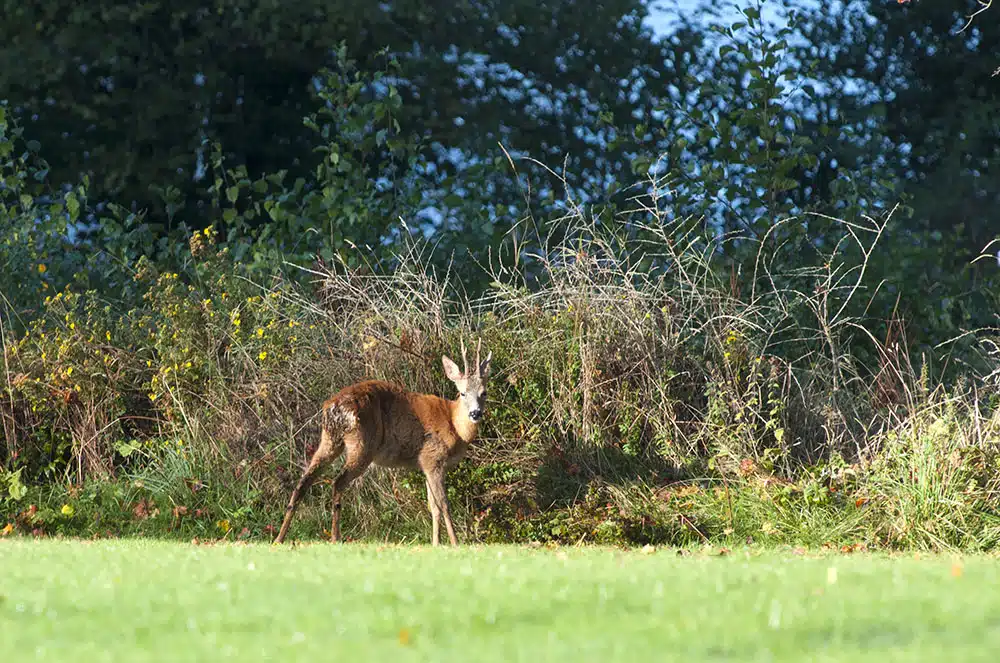
Velvet antlers
In cases of disease-related changes in one of the organs that produce growth hormones and sex hormones (pituitary gland, thyroid gland, adrenal glands, or testicles), the hormonal balance can become disturbed so that the antlers grow uncontrollably and the velvet skin is not rubbed off. This leads to the so-called velvet antlers. Velvet antlers can grow down over the eyes and result in the animal not surviving.
Velvet antlers are relatively common in roe deer but very rare in other wild deer species. Antlers that resemble velvet antlers can develop in female roe deer, especially in older does.
Summary
- Roe deer thrive best in varied terrain with both forest and open areas.
- Long and snowy winters can make it difficult for roe deer to survive, and they should then be given supplemental feeding.
- Roe deer are most active at dawn and dusk.
- The diet consists mainly of many different kinds of herbs, leaves, fine twigs, and brush.
- The buck marks out its territory by rubbing against trunks and branches so that bark comes off and twigs break.
- The rutting season begins already in July–August, earlier than for any other of our deer species. The fawn is born in May–June.
- In summer, roe deer are warmly reddish-brown; in winter, gray-brown.
- It is very difficult during hunting to reliably distinguish between doe and young female.
- More than half of all roe deer fawns are killed at a young age by foxes or mowing machines.
- Hairless skin areas in roe deer are caused by chewing lice.
